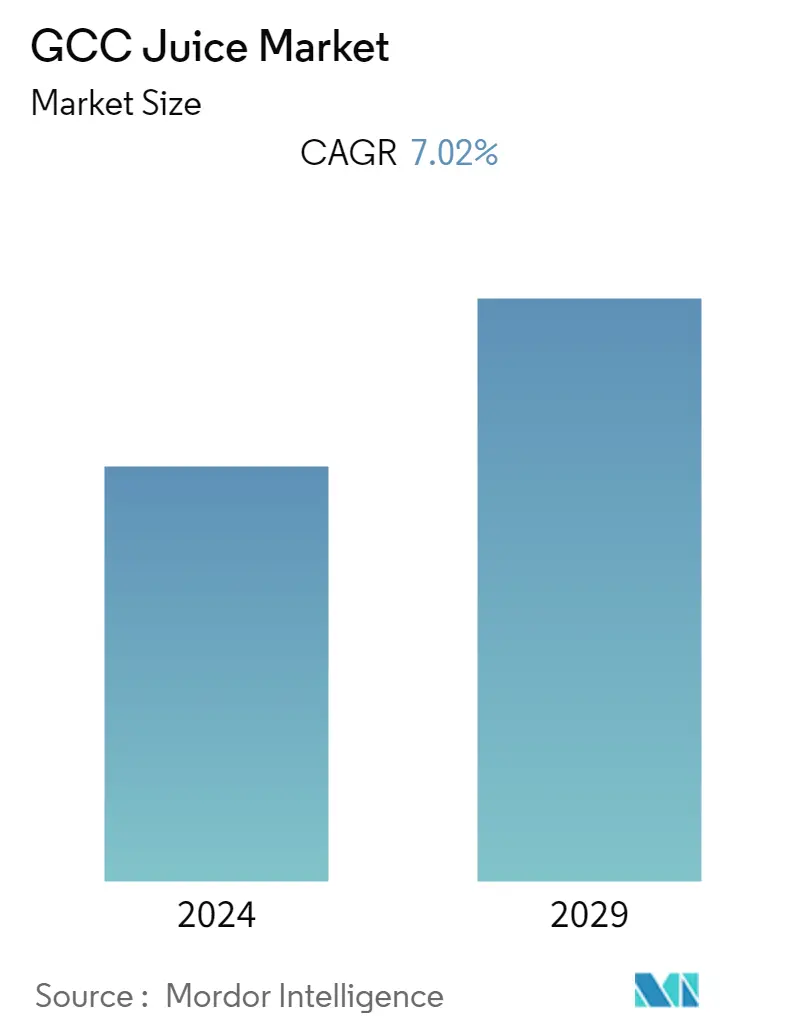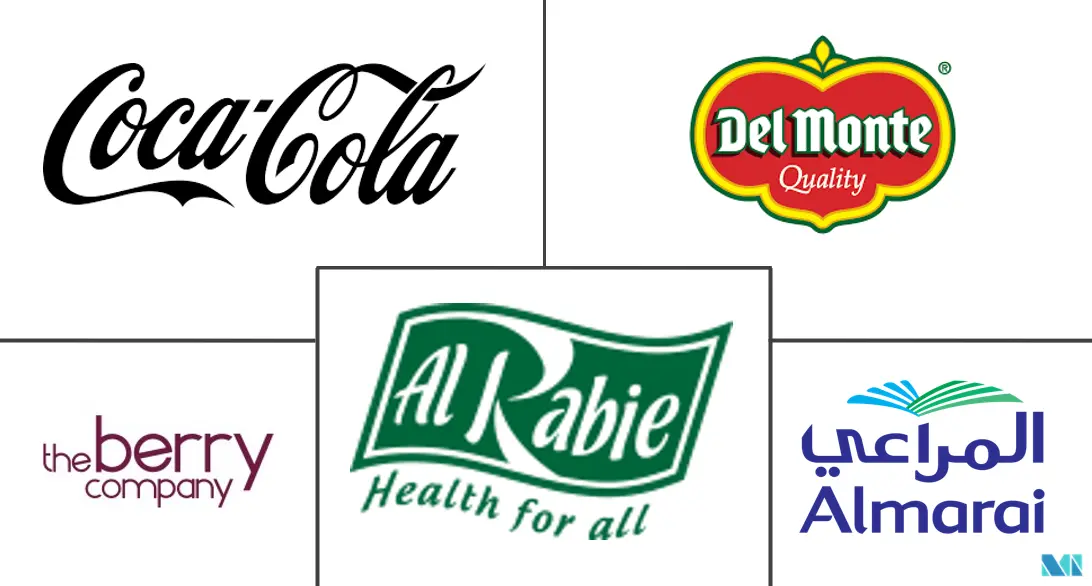Market Size of GCC Juice Industry

| Study Period | 2019 - 2029 |
| Base Year For Estimation | 2023 |
| Forecast Data Period | 2024 - 2029 |
| Historical Data Period | 2019 - 2022 |
| CAGR | 7.02 % |
| Market Concentration | Low |
Major Players
*Disclaimer: Major Players sorted in no particular order |
GCC Juice Market Analysis
The GCC juice market is projected to grow at a CAGR of 7.02% during the forecast period.
Across Middle Eastern countries, the demand for juices and nectars has doubled over the past couple of years, primarily for premium juice products. Consumption is rising, driven by the affluent Gulf States, mainly Saudi Arabia and the United Arab Emirates. Higher demand for value-added products, such as juices containing vegetables, seeds, and other ingredients, has been witnessed in recent years. Fruit juice is expected to account for a significant share of the market studied. Brands' novel offerings, growing consumer awareness toward juice consumption, and increasing disposable income are some major factors driving the GCC juice market.
Moreover, drinking beverages with added artificial sweeteners can increase the risk of obesity and other health problems such as type 2 diabetes, cardiovascular disease, and others. This is propelling the demand for natural beverages, such as fruit juices that do not contain added preservatives. According to the Organic Trade Association, due to the high prevalence of obesity in some GCC nations, such as the United Arab Emirates, where 40% of the population were obese as of 2022, consumers in the GCC region are becoming more health concerned. To encourage people to make healthier choices, most countries in the region have imposed a tax on sugar-sweetened beverages and concentrates. These factors are propelling the free-from, organic juice market across the GCC market.
GCC Juice Industry Segmentation
As per the scope of the report, juice is a beverage created by pressing or extracting the natural liquid in fruits and vegetables. GCC Juice Market is segmented by product type, distribution channel, and geography. Based on product type, the market is segmented into fruit juice, vegetable juice, nectar, and other product types, by distribution channel into hypermarkets and supermarkets, convenience stores, online stores, and other distribution channels. By Geography, the market is studied for Saudi Arabia, the United Arab Emirates, Qatar, and the Rest of the Gulf Cooperation Council. For each segment, the market sizing and forecasts have been done based on value (in USD million).
| Product Type | |
| Fruit Juice | |
| Vegetable Juice | |
| Nectar | |
| Other Product Types |
| Distribution Channel | |
| Supermarkets and Hypermarkets | |
| Convenience Stores | |
| Online Stores | |
| Other Distribution Channels |
| Geography | |
| United Arab Emirates | |
| Saudi Arabia | |
| Qatar | |
| Rest of Gulf Cooperation Council |
GCC Juice Market Size Summary
The GCC fruit juice market is experiencing significant growth, driven by increasing consumer demand for premium and value-added juice products. This surge in demand is particularly notable in affluent Gulf States like Saudi Arabia and the United Arab Emirates, where there is a growing preference for juices that incorporate vegetables, seeds, and other ingredients. The market is further bolstered by brands introducing novel offerings and a rise in consumer awareness about the benefits of juice consumption. As disposable incomes rise, consumers are increasingly seeking natural beverages free from artificial sweeteners and preservatives, aligning with health trends and government initiatives such as taxes on sugar-sweetened beverages. This shift is propelling the organic and free-from juice segments, catering to health-conscious consumers in the region.
The retail landscape in the GCC is undergoing transformative changes, with a growing number of price-sensitive consumers and a demand for personalized, value-driven, and convenient shopping experiences. The expansion of large-scale malls and supermarkets, coupled with the rise of e-commerce, is facilitating increased juice sales. The market is highly fragmented, with numerous local and global players competing for market share. Key industry players are focusing on expanding production capacities and engaging in mergers and acquisitions to enhance their product offerings and technical expertise. The introduction of innovative products, such as naturally sweetened fruit drinks, reflects the industry's responsiveness to evolving consumer preferences and market dynamics.
GCC Juice Market Size - Table of Contents
-
1. MARKET DYNAMICS
-
1.1 Market Drivers
-
1.2 Market Restraints
-
1.3 Porter's Five Forces Analysis
-
1.3.1 Threat of New Entrants
-
1.3.2 Bargaining Power of Buyers/Consumers
-
1.3.3 Bargaining Power of Suppliers
-
1.3.4 Threat of Substitute Products
-
1.3.5 Intensity of Competitive Rivalry
-
-
-
2. MARKET SEGMENTATION
-
2.1 Product Type
-
2.1.1 Fruit Juice
-
2.1.2 Vegetable Juice
-
2.1.3 Nectar
-
2.1.4 Other Product Types
-
-
2.2 Distribution Channel
-
2.2.1 Supermarkets and Hypermarkets
-
2.2.2 Convenience Stores
-
2.2.3 Online Stores
-
2.2.4 Other Distribution Channels
-
-
2.3 Geography
-
2.3.1 United Arab Emirates
-
2.3.2 Saudi Arabia
-
2.3.3 Qatar
-
2.3.4 Rest of Gulf Cooperation Council
-
-
GCC Juice Market Size FAQs
What is the current GCC Juice Market size?
The GCC Juice Market is projected to register a CAGR of 7.02% during the forecast period (2025-2030)
Who are the key players in GCC Juice Market?
Almarai Company, The Coco Cola Company, Al Rabie Saudi Foods Co, Del Monte Foods, Inc and The Berry Company, LLC are the major companies operating in the GCC Juice Market.

